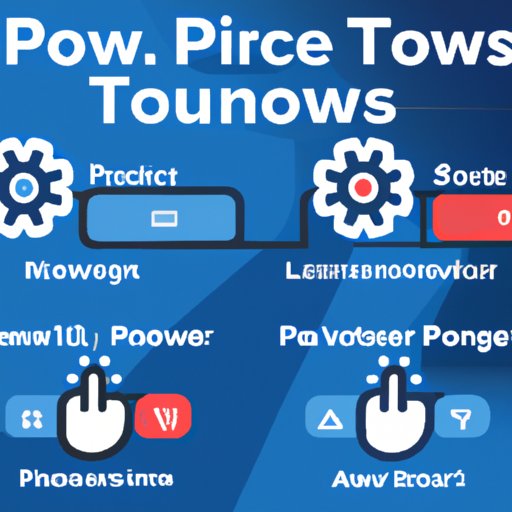Introduction
Power Automate is a powerful automation tool that enables users to quickly and easily build automated workflows. It allows users to connect various applications and services together, creating end-to-end workflows that can be triggered by a variety of events. In this article, we will explore how to create workflows in Power Automate, including understanding the steps involved, exploring triggers and actions, looking at common use cases, and reviewing best practices for creating effective workflows.

Overview of Power Automate and its Benefits
Power Automate is part of the Microsoft Power Platform and provides a range of features and capabilities for automating business processes. It enables users to quickly and easily create workflows that can be triggered by different events or conditions and then execute a series of tasks automatically. This makes it possible to automate manual processes and save time and resources, as well as reduce the risk of human error.
Power Automate also offers a wide range of connectors that allow users to integrate with other applications and services, making it easier to create complex workflows. Additionally, it has a visual editor that makes it easy to create and modify workflows, as well as an intuitive user interface that allows users to quickly understand how to create and manage workflows.

Understanding the Steps Involved in Creating a Power Automate Workflow
The first step in creating a Power Automate workflow is to define the trigger or event that will initiate the workflow. A trigger can be anything from a new item being added to a list in SharePoint, an email being received, or a button being clicked. Once the trigger has been identified, the next step is to define the actions that will take place when the trigger occurs. Actions can include sending an email, creating a task in Planner, or posting a message to Teams.
Once the trigger and actions have been defined, the next step is to configure the settings for the workflow. This includes setting conditions, defining variables, and configuring any notifications that should be sent. After the settings have been configured, the workflow can be tested to ensure it is working as expected. Finally, the workflow can be published so that it can be used by other users.

Triggers and Actions for Power Automate Workflows
Triggers and actions are the building blocks of Power Automate workflows. Triggers are events that initiate a workflow and can include things like new items being added to lists, emails being received, or buttons being clicked. Actions are the tasks that are performed after a trigger occurs and can include sending an email, creating a task in Planner, or posting a message to Teams.
Triggers and actions can be combined to create powerful workflows that can automate manual processes and save time and resources. For example, a workflow could be created to automatically send a notification when a new item is added to a list in SharePoint, or to post a message to Teams when an email is received.
To demonstrate how to use triggers and actions for Power Automate workflows, let’s take a look at a simple example. In this example, we will create a workflow that will send an email when a new item is added to a SharePoint list. First, the trigger will be set to detect when a new item is added to the list. Then, an action will be added to send an email with the details of the new item.
Once the trigger and action have been configured, the workflow can be tested to ensure it is working as expected. If everything is working correctly, the workflow can then be published so that it can be used by other users.
Common Use Cases for Power Automate Workflows
Power Automate workflows can be used for a variety of tasks and processes, ranging from simple notifications to more complex processes. Here are some common use cases for Power Automate workflows:
- Sending notifications when new items are added to SharePoint lists or when emails are received.
- Posting messages to Teams when specific events occur.
- Creating tasks in Planner when a deadline is approaching.
- Automating data entry and updating records in databases.
- Generating reports based on data stored in different systems.
- Integrating applications and services to create end-to-end workflows.
These are just a few examples of how Power Automate workflows can be used. As you can see, there are many possibilities for using Power Automate to automate processes and save time and resources.
Best Practices for Designing Effective Power Automate Workflows
Designing effective Power Automate workflows requires careful planning and consideration. Here are some best practices for designing effective Power Automate workflows:
- Understand the purpose of the workflow before designing it.
- Identify the triggers and actions that will be used in the workflow.
- Test the workflow to ensure it is working as expected.
- Ensure the workflow is secure and compliant with security policies.
- Optimize the workflow for efficiency and performance.
- Monitor the workflow for any errors or issues.
By following these best practices, you can ensure that your Power Automate workflows are designed effectively and efficiently.
Conclusion
Power Automate is a powerful automation tool that can be used to quickly and easily build automated workflows. In this article, we explored how to create workflows in Power Automate, including understanding the steps involved, exploring triggers and actions, looking at common use cases, and reviewing best practices for creating effective workflows.
By following the steps outlined in this article, you should be able to create workflows in Power Automate that are efficient and effective. With the right combination of triggers and actions, you can create powerful workflows that can automate manual processes and save time and resources.
(Note: Is this article not meeting your expectations? Do you have knowledge or insights to share? Unlock new opportunities and expand your reach by joining our authors team. Click Registration to join us and share your expertise with our readers.)
